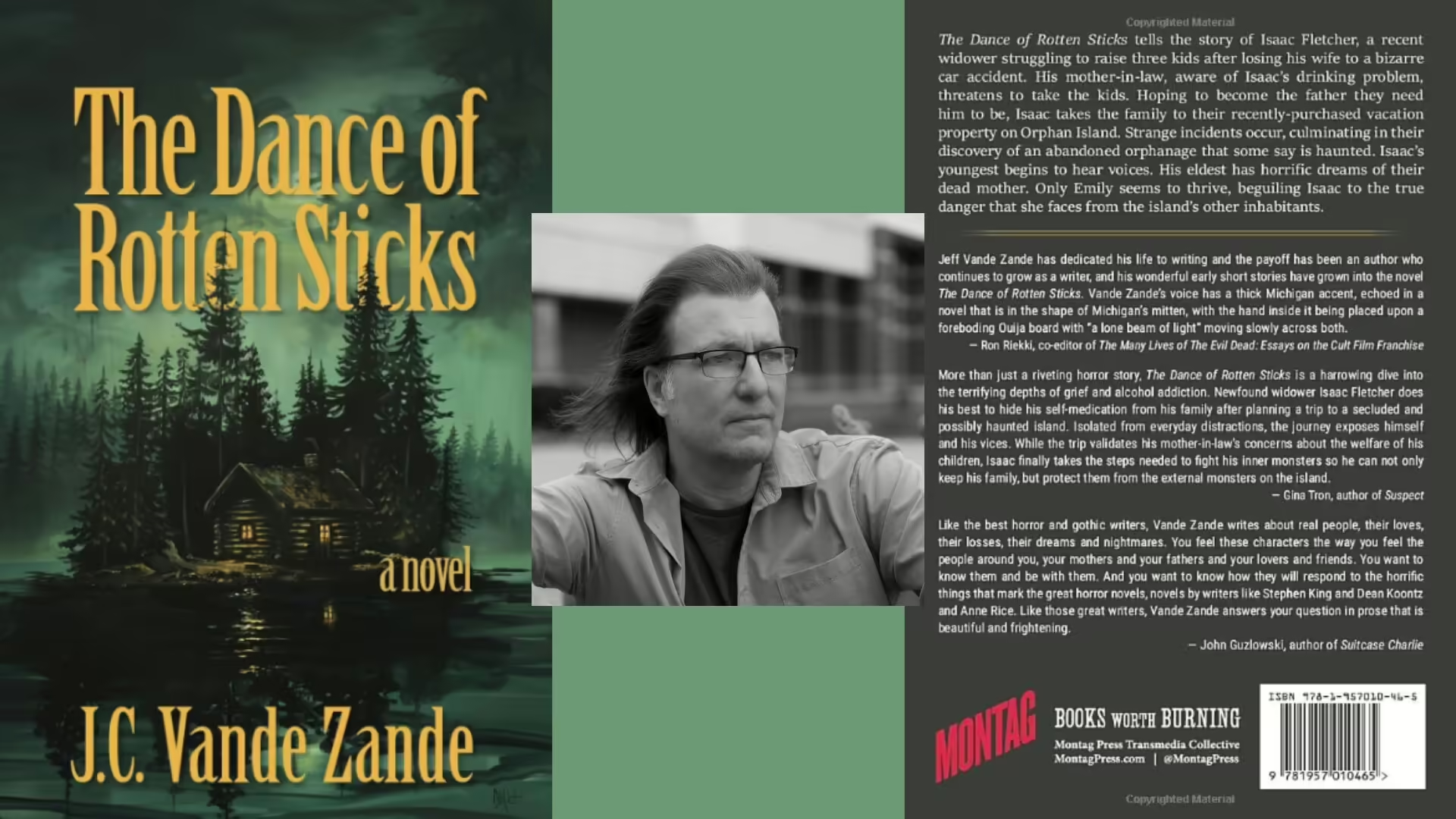The literary snob in Jeff Vande Zande ignored the idea brewing in his brain for most of the summer of 2020. How could he possibly think about putting those thoughts on paper when they were—gasp! —so far off from the genre he usually pursued?
With five novels under his belt, most fell neatly into the literary realism category with some dystopian here and there. This new plotline, however, tiptoed into gothic horror territory. “I fought it when the idea first came to me,” he said. “I’m not a horror writer and I kept thinking that I’m not going to do this.”
Still, the more he tried to disregard the concept, the louder it became inside his head. At that point, he decided to share his story idea with a friend with whom he did a lot of fly fishing. With the pandemic in full swing, Vande Zande had plenty of time on his hands. Some of that time was spent at his friend’s cabin on Island Lake in Northern Michigan. “My fishing buddy finally told me I should stop talking to him about the idea for the novel and just write it instead of browbeating myself about not being a horror writer,” Vande Zande said, laughing. “That kind of inspired me, so I decided to give it a shot.”
The result was “The Dance of Rotten Sticks,” the story of widower Isaac Fletcher’s struggles to raise three kids after losing his wife in a tragic accident (all while fighting a losing battle with alcoholism). The setting for the bulk of the storyline happens on an island not that dissimilar to Vande Zande’s friend’s spot.
So, where’s the scary, right? Oh, there’s plenty of suspense and mystery just around the corner.
It’s just a family getaway … right?
Eager to get his act together and prove to his children he can be the parent they need, Isaac packs them up and heads to a cabin on the secluded Orphan Island that he and his wife bought together—but never had the chance to enjoy—before her death.
Joining them on the journey is Isaac’s brother, Adam. The family is also expecting Isaac’s mother-in-law, Helen, to help celebrate a birthday party for one of the children. She doesn’t arrive at the scene until a few days later. There’s a whole subplot going on between Isaac and Helen that ratchets up the tension on the island.
Without giving away too much of the plot, let’s just say a series of strange things happen to the family once they arrive at the cabin. Adding to the angst is the fact that the island can only be accessed by boat. Caleb, a lovely pontoon boat operator from the mainland, transports Isaac and his family to the island. He gives him flags to use to signal if they need to be picked up which vary in color based on the urgency of the request.
Readers can easily sense things aren’t going to end well with a family that’s already experiencing trauma, essentially trapped on an island they can’t easily escape. Talk about being forced to face your demons (literally and figuratively).
Now, you won’t find Stephen King levels of gore in Vande Zande’s book. That’s just not his thing. And that’s OK because the book is plenty scary without it. “I don’t want to write gore or torture,” he said. “I spilled a little blood in the book, but I wanted to lean more on mystery and suspense.”
Who cares about this family, anyway?
Readers can’t help but form a strong bond with the characters in Vande Zande’s book. The main character, Isaac, shares a lot of characteristics with the author who created him. “The main thing I wanted to deal with through Isaac was my own alcoholism,” he said. “I was still actively drinking while I was writing a novel about a guy trying to quit. I almost wonder if I was writing to myself and having thoughts about my own fatherhood and worries about whether I was being everything I could be for my kids.”
Describing himself as a functional alcoholic during his drinking days, Vande Zande said he is now proud to say he’s in recovery. Part of that process was the people around him doubting he had really quit. We see some of that struggle played out with Isaac throughout the book.
Isaac’s brother, Adam, is the embodiment of symbolism and intentionally serves as a foil to the main character. He’s everything Isaac wishes he could be for his children. In one scene, we see Isaac enviously watching his brother down on the floor of the cabin playing cars with his son, Carson. “Obviously, Isaac loves his brother, but by inviting him on the cabin trip, he was still putting a barrier between himself and his kids,” said Vande Zande. “He watches his kids connect more with his brother than with him.”
The three children have unique personalities and storylines that help support the main plot. Carson is the youngest and has had difficulty with sleepwalking since his mother’s death. His middle child, Emily, is central to the main plot, making it difficult to reveal too much about her other than to say she’s open-minded to the supernatural. His eldest daughter, Ashley—a full-on moody teenager—has her own burdens to bear as the pseudo-parent to her younger siblings.
Vande Zande’s ability to fully form them into likable characters only serves to strengthen the eventual gut punch he hits readers within the final chapter.
What’s with the creepy ghost girls?
What would a gothic horror novel be without some vengeful spirits, right? Readers don’t have to wait very long to discover how Orphan Island got its name. Without giving away too much of the story, the island once was home to an orphanage for young girls. A tragic boating accident claimed the lives of several of the orphans, leaving the locals to spin tales about the island being haunted.
The remnants of the orphanage can still be found on the island. We see Isaac and Adam explore the outskirts of the place, with Adam dedicating even more time later in the book to learning its backstory.
We won’t spoil the role the ghost girls have in “The Dance of Rotten Sticks,” but trust us when we say the plot twist will leave readers wanting more.
There are other characters in the book who are central to the plot. This review deliberately leaves them out so as not to give too much away. Let’s just say there’s more creepiness going on in this book than the ghost girls.
But what about his inner literary snob?
It took Vande Zande some time to accept that horror is a legitimate literary genre. Once he was willing to embrace that realization, he knew he could still find ways to appease his inner literary snob. “You can still say things with horror,” he said. “Sometimes, I think you can say things more explicitly through the symbolism of horror.”
While the book contains literal monsters, Isaac’s struggle with alcohol was a figurative monster that proved almost as formidable an opponent. It’s just one example of how Vande Zande embraced the genre while still appeasing his inner literary critic.
One of the ways he managed to placate his inner turmoil over wading into the genre was to be a stickler with the details. He spent considerable time learning about the invasive lamprey species and how lampricide is used to kill them (both central to the main plot).
He also was careful not to describe Orphan Island as a true island because it has a river flowing through it. Vande Zande said he learned during his research that he would have to create a huge island to realistically accommodate a river, and that didn’t jive with his storyline. “Sure, I could have made stuff up, but I’m a stickler about that kind of stuff. That’s why I gave the island a southern shore that’s connected to a swamp you can’t really traverse. I wanted flowing water, but I wanted it to be accurate.”
Even with those accommodations, Vande Zande said he felt like he should focus on a character in existential angst. “It took a while for me to forgive myself for writing this book and realizing that horror can be just as effective at tapping into the human condition.”
What’s that about a sequel?
Those who have already read the book will likely be excited to learn Vande Zande has planned a sequel. He’s 8,000 words into the follow-up and is at the critical juncture of bridging “The Dance of Rotten Sticks” with the sequel, tentatively titled “Shadows of the Witness Tree.”
In the forthcoming novel, we catch up with Isaac and his family 11 years after their fateful trip to Orphan Island. The book will be set in the Pigeon River Forest, another place Vande Zande knows well.
“The hard part of finding the energy for a sequel is making sure I have fuel, that a sequel might be warranted,” he said. “Who am I writing this sequel for? Who is reading this? It’s a real ebb and flow of energy.”
While he hasn’t thought that far ahead, Vande Zande said he’s not opposed to turning the original idea into a series. He said three books is a nice number for a series. If he decides to move forward with that plan at the conclusion of the sequel, he said he’ll add an epilogue like the one found at the end of “The Dance of Rotten Sticks” to set it up for a third and final book.
It’s taking longer to write the sequel than the first book, he said. He’s busier now and must work on writing around his other responsibilities, including a teaching gig at Delta College.
Vande Zande said readers like the idea of a book series because they become invested in the characters and want to continue their journey with them. It’s a loss for readers and writers when books eventually end.
“The big fear for me right now is will there be another idea when I’m done with this?” he said. “So, in a way, I don’t mind that the sequel is taking me so long to write. For now, I get to live in this world that I’m creating for a longer time.”

